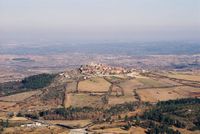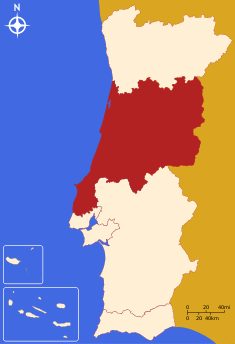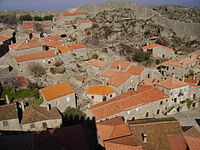- Centro Region, Portugal
-
Centro Região Centro Region Symbolic of the Central Region, the Serra da Estrela the highest peak/mountain range in continental PortugalName origin: centro, Portuguese for centre Country  Portugal
PortugalRegion Centro Capital Coimbra - elevation 119 m (390 ft) - coordinates 40°12′28″N 8°25′34″W / 40.20778°N 8.42611°W Lowest point Sea level - location Atlantic Ocean Area 28,462 km2 (10,989 sq mi) Population 2,327,026 (2011) Density 81.76 / km2 (212 / sq mi) Timezone WET (UTC+0) - summer (DST) WEST (UTC+1) ISO PT NUTS PT16 GDP per capita (PPS) € 15,300 (2006)[1] Website: https://www.ccdrc.pt/ Statistics from INE (2005); geographic detail from Instituto Geográfico Português (2010) The Centro Region (Portuguese: Região Centro, IPA: [ʁɨʒiˈɐ̃w ˈsẽtɾu]) is a region in central Portugal, and its capital is Coimbra. Other local cities with major administrative status inside this region are Aveiro, Viseu, Leiria, Castelo Branco and Guarda. It is one of seven Regions of Portugal (NUTS II subdivisions). This is one of the regions of Europe, considered by the European Union for statistical and geographical purposes. Its population in 2011 totalled 2,327,026 inhabitants[2], and its area is 28,462 km² (density of 82 inhabitants per square kilometre).
Contents
History
 The ancient ruins at Conímbriga, the best preserved ruins in the ancient Roman province of Lusitania.
The ancient ruins at Conímbriga, the best preserved ruins in the ancient Roman province of Lusitania.
Inhabited by the Lusitanians, an Indo-European people living in the western Iberian Peninsula, the Romans settled in the region and colonized it as a part of the Roman Province of Lusitânia. The Roman town of Conímbriga, near Coimbra, is among the most noted and well preserved remains of that period. After the fall of the Roman Empire, Visigoths were the main rulers and colonizers from the 5th to the 8th century.
In the 8th century the Muslim conquest of Iberia turned the region a Muslim-dominated territory.
In the earliest years of the Christian Reconquista, just before the arise of a Portuguese national identity, the region was a battleplace for Muslim Moors and Christian crusaders. Once the Moors were expelled, the Christian kings and landlords made the region a county, the County of Coimbra. It was integrated into the newly-created Condado Portucalensis, the early precursor of the modern nation of Portugal.
The modern region matches roughly the boundaries of the older historical Beira Province plus the Oeste in former Estremadura and Médio Tejo in former Ribatejo. Beira was an historical province of Portugal and its name was used by the heirs to the Portuguese throne during the monarchy regime, before 1910. The princes were known as the Princes of Beira.
Historic villages
 The hilltop keep of Castelo Rodrigo
The hilltop keep of Castelo Rodrigo
Along this region’s mountainous border with Spain are a series of fortresses and castles that once protected the country from its many invaders. Over the centuries, Moors and Christians, Spaniards and Portuguese have all tried to take these villages, but their higher elevations usually gave them a distinct advantage. Here, the more than one dozen fortified frontier villages beckon today’s visitors to come explore a 900-year history—full of the heroism, epic battles and romance upon which Portugal struggled to become a nation. Each village has a fascinating tale of its own to tell. All of their valiant efforts paid off. Today Portugal boasts the longest-standing border in all of Europe.
In these rural villages, ancient rituals and religious festivals remain popular. Visitors can sample them and partake in traditional foods such as cheese, sausages and mountain honey.
In the fortress town of Almeida, a walk through the narrow cobbled streets can lead a visitor to the ruins of a once mighty 12-pointed fortress here. One of Portugal’s many Pousadas—an historic property turned into an inn—is located in Almeida. In the town of Castelo Rodrigo, a memorial stone marks the place of a fierce battle in 1664, and visitors can view the remains of the castle, its tower and a palace here. The town has a small, Gothic church. Just near Castelo Mendo stands a beautiful bridge built by the Romans.
Frontier castles
Main article: Castles in PortugalMost of the castles in this border region of Centro are classified as national monuments. These stone fortresses date back to the 11th, 12th and 13th centuries. Castles or parts of castles still stand at Alfaiates, Sortelha, Vilar Maior, Sabugal, Castelo Mendo, Castelo Bom, Castelo Rodrigo, Penamacor, Monsanto, Pinhel and Almeida. A 20-castle route has been delineated by the Portugal government (see www.visitportugal.com). Sortelha, Castelo Mendo, Castelo Rodrigo and the fortified town of Almeida are considered gems among them all.
Geography
The Centro is a region of diversified landscapes. The interior is mountainous with some plateaus, dominated by the Serra da Estrela mountain. The region is plentiful of pine and chestnut trees forests. The green, rugged landscape of this region is crisscrossed by rivers. Several river valleys at the foot of the mountains have a full bodied charm that draw one to outdoor activities like hiking, fishing, tennis and canoeing. In the Winter season, skiing in Serra da Estrela is a popular activity, but in some places, like near the town of Seia skiing before the Winter season is possible due to artificial snow infrastructures. The coastal plain has several beaches, like the ones of Mira, Figueira da Foz, Ílhavo, Nazaré, Peniche and São Martinho do Porto. Natural landmarks in this region are the Serra da Estrela mountain range (the biggest and highest in mainland Portugal), with its Serra da Estrela Natural Park, the Mondego river (the longest river located exclusively in Portuguese territory), the Aveiro Lagoon (Ria de Aveiro) and the coastal beaches.
The largest urban centres include Coimbra, Aveiro, Viseu, Leiria, Covilhã, Castelo Branco, Figueira da Foz, Guarda, Pinhel, Mealhada, Pombal, Tomar, Abrantes, Torres Vedras, Torres Novas, Peniche, Águeda, Cantanhede and Caldas da Rainha.
Subregions
The region is divided in twelve sub-regions:
- Baixo Mondego
- Baixo Vouga
- Beira Interior Norte
- Beira Interior Sul
- Cova da Beira
- Dão-Lafões
- Pinhal Interior Norte
- Pinhal Interior Sul
- Pinhal Litoral
- Serra da Estrela
Economy
One of Portugal's richest regions by the abundance of natural streams of water, forests, arable land and the long coast line, the Centro region has some of the most economically dynamic and densely populated municipalities of the country. Excellent transportation links with the Lisbon Metropolitan Area to the south and the Porto Metropolitan Area to the north, making ocean, rail and motorway access possible via containers, have all contributed to making manufacturing the principal industry, found mainly in the littoral strip, which is one of the largest industrialized areas in Portugal. Important products include motor vehicles, food, electrical appliances, machinery, chemicals, and paper. Higher education, research and development, healthcare, information technologies, biotechnology, forestry, agriculture, fishing, and tourism, are major activities in he region. The wine regions of Dão DOC and Bairrada DOC are among the most reputed in Portugal. The major industry, commerce and services centres are located in and around Coimbra, Aveiro, Viseu, Leiria, Covilhã, Castelo Branco, and Figueira da Foz. Important light industry and agriculture is also based in and around Guarda, Torres Novas, Torres Vedras and Caldas da Rainha.
Education
The Centro region has three public universities: the University of Coimbra, which is the oldest Portuguese university and the largest in the region; the Aveiro University; and the University of Beira Interior. There are also five state-run polytechnical institutes: Castelo Branco Polytechnical Institute; Coimbra Polytechnical Institute; Guarda Polytechnical Institute; Leiria Polytechnical Institute; and Viseu Polytechnical Institute. In addition there are also a large number of public nursing schools and private higher education institutions across the region.
See also
- Regions of Portugal
References
- Notes
- ^ "GDP per inhabitant in 2006 ranged from 25% of the EU27 average in Nord-Est in Romania to 336% in Inner London". Eurostat. http://epp.eurostat.ec.europa.eu/pls/portal/docs/PAGE/PGP_PRD_CAT_PREREL/PGE_CAT_PREREL_YEAR_2009/PGE_CAT_PREREL_YEAR_2009_MONTH_02/1-19022009-EN-AP.PDF.
- ^ "Censos 2011 Resultados Preliminares 2011". INE. http://www.ine.pt/scripts/flex_v10/Main.html.
External links
- Centro de Portugal (Official Centro Tourism site)
- Região Centro (About Centro region)
 NUTS 2 regions, NUTS 3 subregions and Districts of Portugal
NUTS 2 regions, NUTS 3 subregions and Districts of PortugalNorte Region Subregions: Alto Trás-os-Montes · Ave · Cávado · Douro · Entre Douro e Vouga · Grande Porto · Minho-Lima · Tâmega · Districts: Braga · Bragança · Porto · Viana do Castelo · Vila Real · Aveiro * · Guarda * · Viseu *Centro Region Subregions: Baixo Mondego · Baixo Vouga · Beira Interior Norte · Beira Interior Sul · Cova da Beira · Dão-Lafões · Médio Tejo · Oeste · Pinhal Interior Norte · Pinhal Interior Sul · Pinhal Litoral · Serra da Estrela · Districts: Castelo Branco · Coimbra · Leiria · Aveiro * · Guarda* · Santarém * · Viseu *Lisboa Region Alentejo Region Algarve Region Subregions: Algarve · Districts: FaroAzores Subregions: AzoresMadeira Subregions: Madeira(*) Situated in more than one Region. NOTE: The Azores and Madeira are Autonomous Regions: districts have been discontinued in these areas and local government replaced by LAU1 and LAU2 authorityCategories:- NUTS 2 statistical regions of the European Union
- NUTS 2 statistical regions of Portugal
Wikimedia Foundation. 2010.




